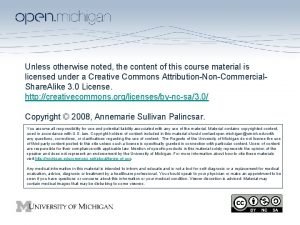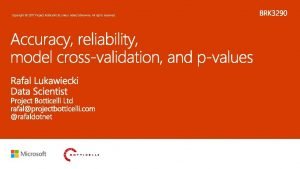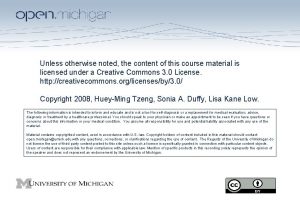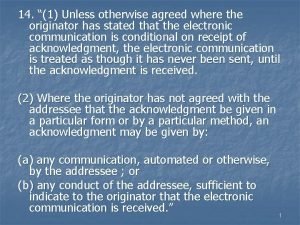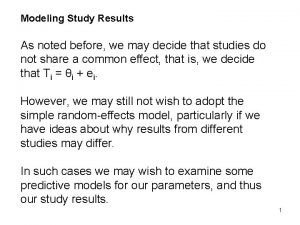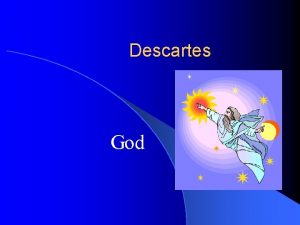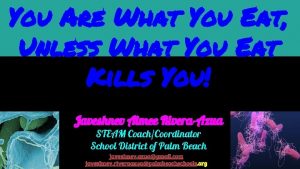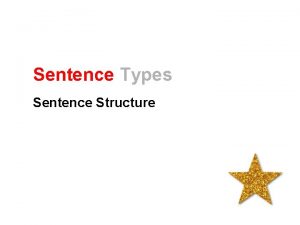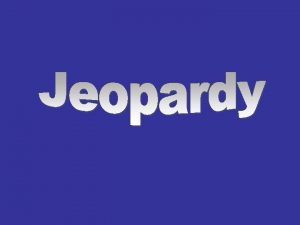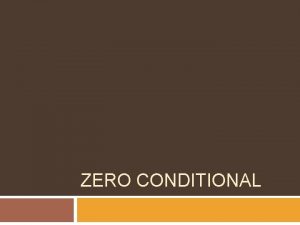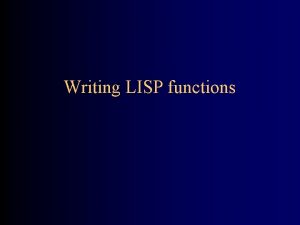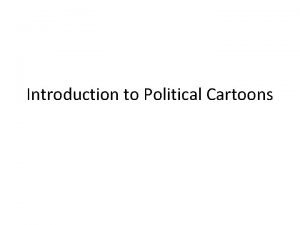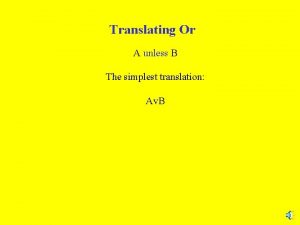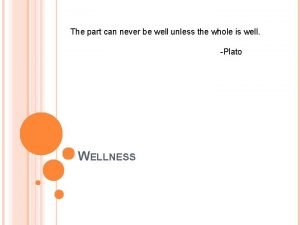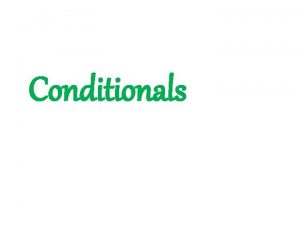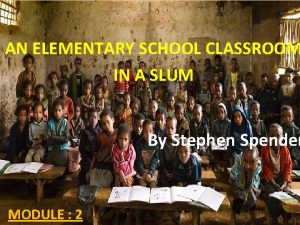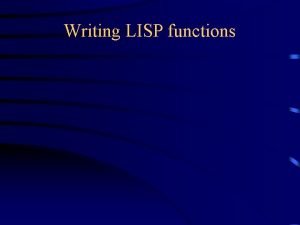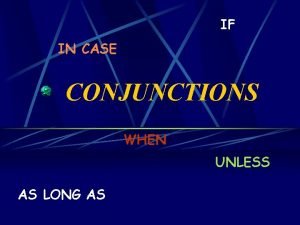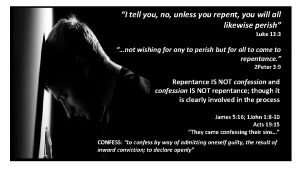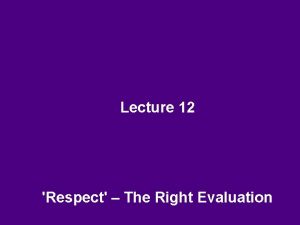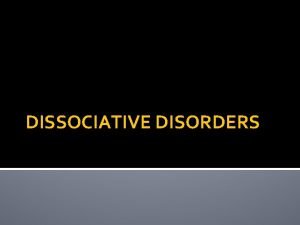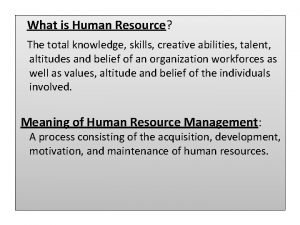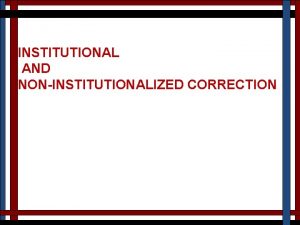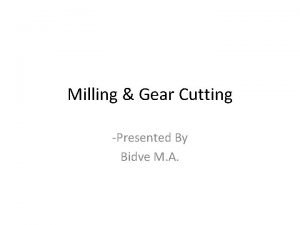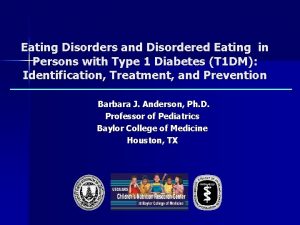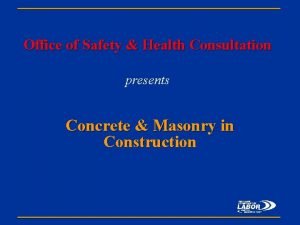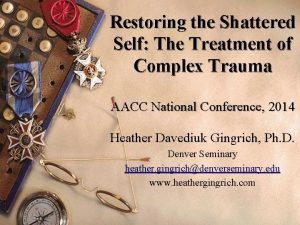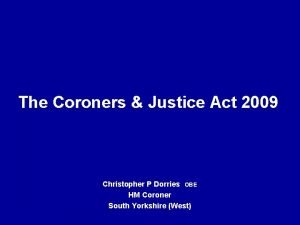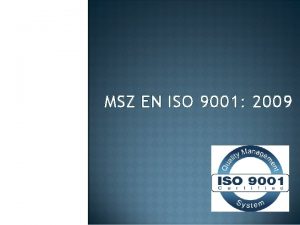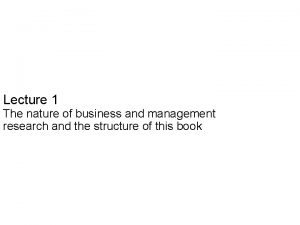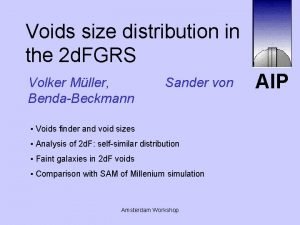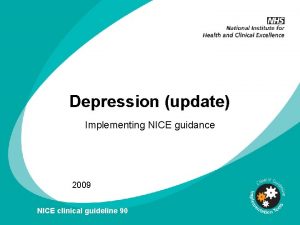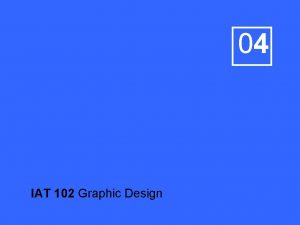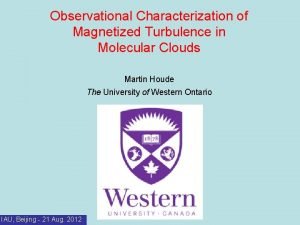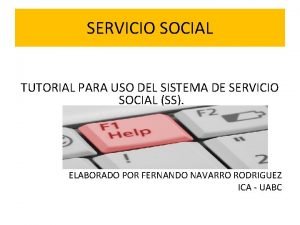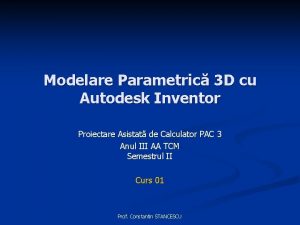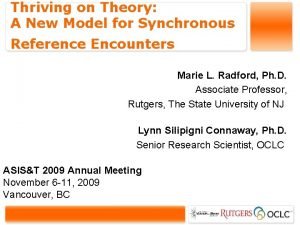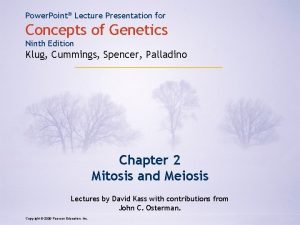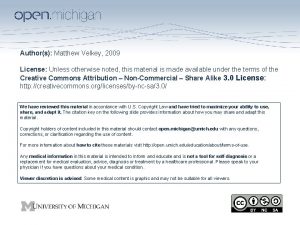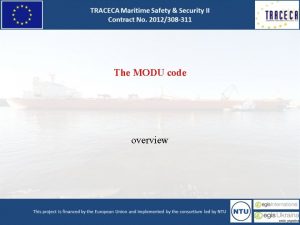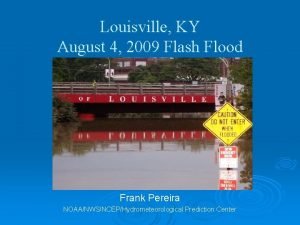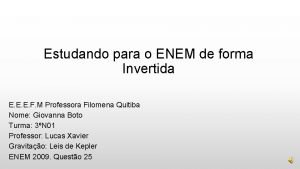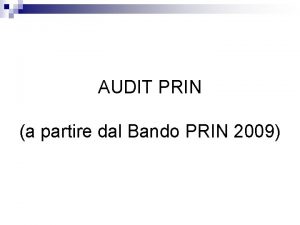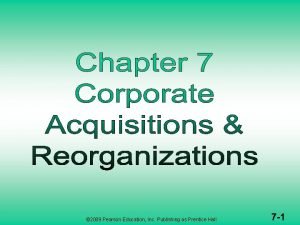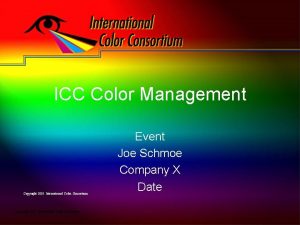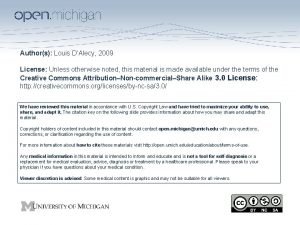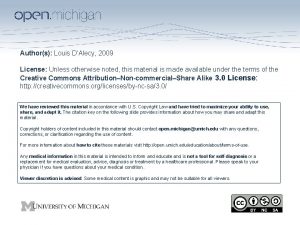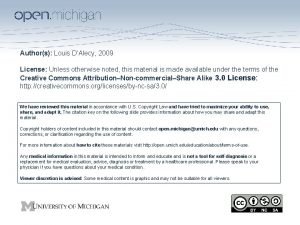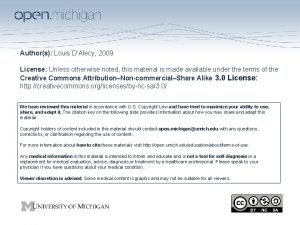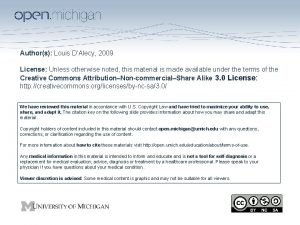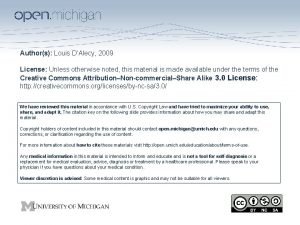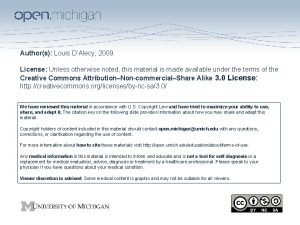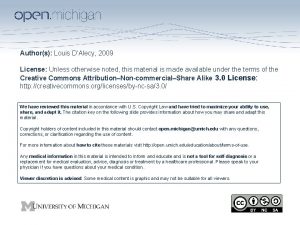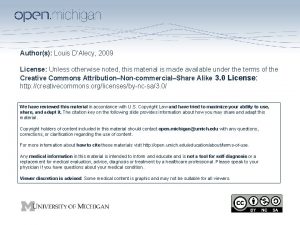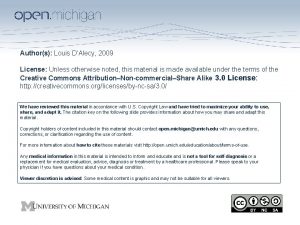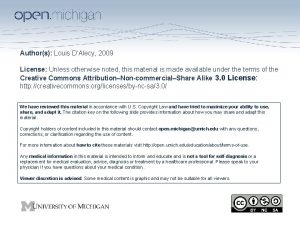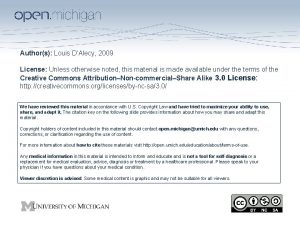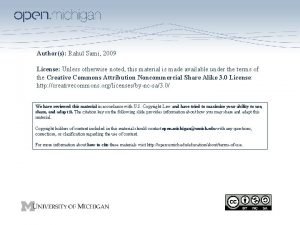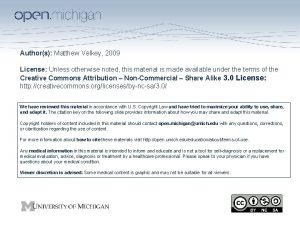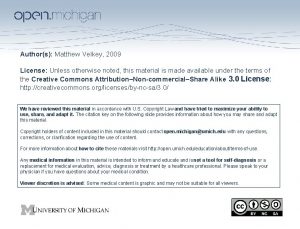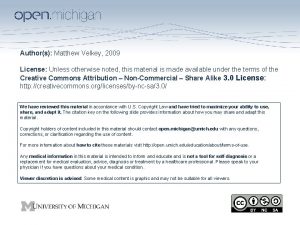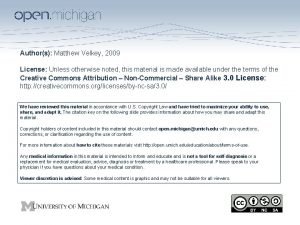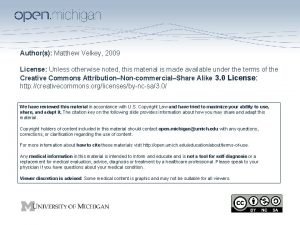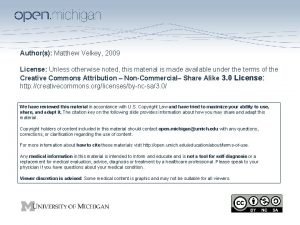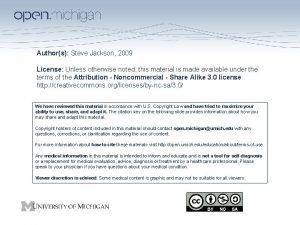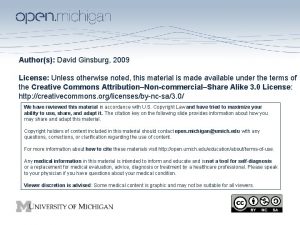Authors Louis DAlecy 2009 License Unless otherwise noted































































- Slides: 63

Author(s): Louis D’Alecy, 2009 License: Unless otherwise noted, this material is made available under the terms of the Creative Commons Attribution–Non-commercial–Share Alike 3. 0 License: http: //creativecommons. org/licenses/by-nc-sa/3. 0/ We have reviewed this material in accordance with U. S. Copyright Law and have tried to maximize your ability to use, share, and adapt it. The citation key on the following slide provides information about how you may share and adapt this material. Copyright holders of content included in this material should contact open. michigan@umich. edu with any questions, corrections, or clarification regarding the use of content. For more information about how to cite these materials visit http: //open. umich. edu/education/about/terms-of-use. Any medical information in this material is intended to inform and educate and is not a tool for self-diagnosis or a replacement for medical evaluation, advice, diagnosis or treatment by a healthcare professional. Please speak to your physician if you have questions about your medical condition. Viewer discretion is advised: Some medical content is graphic and may not be suitable for all viewers.

Citation Key for more information see: http: //open. umich. edu/wiki/Citation. Policy Use + Share + Adapt { Content the copyright holder, author, or law permits you to use, share and adapt. } Public Domain – Government: Works that are produced by the U. S. Government. (USC 17 § 105) Public Domain – Expired: Works that are no longer protected due to an expired copyright term. Public Domain – Self Dedicated: Works that a copyright holder has dedicated to the public domain. Creative Commons – Zero Waiver Creative Commons – Attribution License Creative Commons – Attribution Share Alike License Creative Commons – Attribution Noncommercial Share Alike License GNU – Free Documentation License Make Your Own Assessment { Content Open. Michigan believes can be used, shared, and adapted because it is ineligible for copyright. } Public Domain – Ineligible: Works that are ineligible for copyright protection in the U. S. (USC 17 § 102(b)) *laws in your jurisdiction may differ { Content Open. Michigan has used under a Fair Use determination. } Fair Use: Use of works that is determined to be Fair consistent with the U. S. Copyright Act. (USC 17 § 107) *laws in your jurisdiction may differ Our determination DOES NOT mean that all uses of this 3 rd-party content are Fair Uses and we DO NOT guarantee that your use of the content is Fair. To use this content you should do your own independent analysis to determine whether or not your use will be Fair.

Hemodynamics M 1 – Cardiovascular/Respiratory Sequence Louis D’Alecy, Ph. D. Fall 2008 3

Monday 11/03/08, 9: 00 Hemodynamics 26 slides, 50 min 1. 2. 3. 4. Pressure & pressure pulses Pressure gradient (perfusion pressure) Determinants of Blood Flow Resistance in series and in parallel 4

Hemodynamics "Hemodynamics is concerned with the forces generated by the heart and the motion of blood through the cardiovascular system. ” from ucdavis. edu Blood Pressures and Blood Flow 5

COUNTER CLOCKWISE ROTATION e l c ri t n e v t f e L LV end-diastolic Volume **** LVEDV **** Flow in Mohrman and Heller. Cardiovascular Physiology. Mc. Graw-Hill, 2006. 6 th ed. 3. 3 MH 6 Pressure up Pressure down Flow out

1 Mc. Graw-Hill 2 3 4 1 7

Pressure different SV same i. e. Flow same Mc. Graw-Hill 8

ARTERIES Store pressure Compliance= ∆ V ∆ P “Stretchability” VEINS Store volume 6. 8 Veins are more compliant than arteries. Mohrman and Heller. Cardiovascular Physiology. Mc. Graw-Hill, 2006. 6 th ed. 9

SV = Loads the spring, i. e. increased volume increases pressure Aortic flow = unloads the spring Mc. Graw-Hill 10

4 1 MAP = Pd + 1/3 Pp 2 Time 3 - Pulse Pressure = (Systolic Diastolic) Source Undetermined 11

Pulse Pressure Increases with age Source Undetermined 12

Flow = Partery - Pvein R Flow is directly proportional to the pressure difference. “pressure gradient” or ∆P 13

Mc. Graw-Hill 14

Arterial Determinants of Perfusion Pressure 90 85 5 0 80 75 70 65 15

90 85 20 15 65 e. g. due to excessive hydration Or Laparoscopic Surgery ? Abdominal Compartment Syndrome Both can compress great veins and reduce visceral perfusion pressure. 16

90 85 5 0 80 75 70 65 90 85 20 15 65 75 70 20 50 15 17

Flow = Partery - Pvein R Flow is directly proportional to ∆P and inversely proportional to R R = resistance 18

Resistance ~ hindrance to flow Series Resistance Add 10 + 20 + 5 = 35 Pi Q = flow Mohrman and Heller. Cardiovascular Physiology. Mc. Graw-Hill, 2006. 6 th ed. 19

F = ∆ P/R 10 = 100/10 10 = 200/20 10 = 50/5 10 = 350/35 Flow is same **Measure flow and pressure drop and calculate resistance. 20 Mohrman and Heller. Cardiovascular Physiology. Mc. Graw-Hill, 2006. 6 ed. th

R = Resistance L = length eta = viscosity r = radius R = Flow = Perfusion Pressure Resistance r = radius X Thus 2 X r produces 16 X flow!! 21

Flow is directly proportional to ∆P and directly proportional to r 4 i. e. the 4 th power of the radius 22

1. 8 MH 25, 000 µm range X 5, 000 Mohrman and Heller. Cardiovascular Physiology. Mc. Graw-Hill, 2006. 6 th ed. 23

Same ∆P Mc. Graw-Hill 24

Parallel Resistance Network With different individual resistances R 1 R 2 R 3 1 = 1 + 1 R R Rp R 1 2 3 p 1 2 3 Flow adds 25 Mohrman and Heller. Cardiovascular Physiology. Mc. Graw-Hill, 2006. 6 th ed.

Another example: Parallel Resistance Network With identical individual resistances Assume you have four vessel paths in parallel and each has the same individual resistance of 4. What is the overall resistance of this parallel network? 26

1 = 1 + 1 + 1 Rt R 1 R 2 R 3 R 4 1 = 1 + 1 + 1 Rt 4 4 4 4 1 = 4 Rt = 1 COMBINED (Total) The parallel resistance network has less resistance than any individual component. 27

Parallel Resistance Network More checkout lines means that there is less resistance to ‘flowing” out of the store. Parallel resistances add as reciprocals. 28

Tissue Blood Flow and Tissue Vascular Resistance (***Assume Perfusion Pressure is Constant ***) • Vasoconstriction • r Rtissue Ftissue • Vasodilation r Rtissue Ftissue = Perfusion Pressure Rtissue 29

Monday 11/03/08, 10: 00 Vascular Smooth Muscle 1. 2. 3. 4. 5. 6. 33 slides, 50 min. Vasoconstrictors and Vasodilators Neural control of resistance Humoral control of resistance Local control of resistance Nitric oxide, Nitric oxide synthase (NOS) Asymmetrical dimethylarginine 30

BLOOD angiotensin II Epi endothelial cell prostacyclin endothelial cell endothelin 2 relax NO vascular smooth muscle 1 histamine contract NE sympathetic nerve adenosine mast cell cardiac muscle 31

VSM can change tension without action potentials VSM tension 0 -40 membrane potential hyperpolarize -50 -60 depolarize time Source Undetermined A change in VSM tension causes vasodilation or vasoconstriction 32

M&H Fig 7. 1 33 Mohrman and Heller. Cardiovascular Physiology. Mc. Graw-Hill, 2006. 6 th ed.

Ca++ calmodulin Ca++ ATP myosin light chain kinase PO 4 ADP myosin D’Alecy regulatory light chain 34

myosin light chain phosphatase ( MLP) Ca MLP MLK P ATP ADP At rest myosin can not bind to actin in absence of light chain phosphorylation D’Alecy Cycling bridges Pi Latch bridges myosin rapidly dissociates from actin upon binding ATP during each cycle dephosphorylated myosin dissociates from actin very slowly producing slow bridge cycling initial rise in muscle tension maintained tension tonic contraction 35

Tends to cause vasoconstriction Mc. Graw-Hill 1 2 Tends to cause vasodilation 36

Mc. Graw-Hill 37

Local Influences on Arterioles (Local = no neural or humoral control) Active Hyperemia Reactive Hyperemia Autoregulation 38

Think of accumulation of vasodilator metabolites. Active hyperemia Reactive Hyperemia = increased blood flow in response to increased metabolic demand = increased blood flow following a period of no flow M&H 7. 3 Mohrman and Heller. Cardiovascular Physiology. Mc. Graw-Hill, 2006. 6 th ed. 39

Reactive Hyperemia Arteriosclerosis Thrombosis Vascular Biology 40

Autoregulation = relatively constant blood flow 8. 4 HM in the face of changed perfusion pressure Time Mohrman and Heller. Cardiovascular Physiology. Mc. Graw-Hill, 2006. 6 th ed. Think of vasodilator metabolite washout. 41

M&H 7. 4 Mohrman and Heller. Cardiovascular Physiology. Mc. Graw-Hill, 2006. 6 th ed. 42

Source Undetermined 43

Other Smooth Muscles Vascular arteries, arterioles, venuoles, veins, lymphatic Gastrointestinal longitudinal vs circular, esophageal, gastric, intestinal sphincter smooth muscles, gallbladder bile and pancreatic ducts Pulmonary tracheal, bronchiolar Urinary System bladder, ureters, urethra Reproductive System uterus, vagina, oviducts, vas deferens, prostate capsule Miscellaneous iris of eye capsule of spleen piloerector muscles of skin hairs myoepithelial cells of glands 44

Spiral cut vessel strip Vessel Ring Tension measurement D’Alecy 45

Historical Response to Ach = contraction !! Direct action on VSM Source Undetermined 46

Vessel with intact endothelium relaxes to Ach !!!!!! Via NO release from EC dil at n o i ict ion c r t s on 47 Source Undetermined

Fig 6. 2 Lilly, L. Pathophysiology of Heart Disease. Lippincott, 2007. 4 th ed. 48

Sheer or Flow Mediated Dilation * FMD * NOS Lilly, L. Pathophysiology of Heart Disease. Lippincott, 2007. 4 th ed. 49

NOS Isoforms, Activity and Inhibition • Three isoforms: endothelial, neuronal and inducible • Catalyze formation of NO and citrulline from L-arg • NO production in endothelium produces------ – Vasodilation, inhibition of platelet aggregation & inhibition of proinflammatory response • Inhibit NOS NO endothelial dysfunction –vasoconstriction –atherogenesis – cardiovascular disease 50

ADMA the newest “bad guy”; maybe? R. H. Boger et. Al, Atherosclerosis Supplements 4 (2003) 1 -3 Asymmetrical Dimethylarginine = ADMA 51

Asymmetrical Dimethylarginine (ADMA) • • • What is it? What can it do? Where does it come from? Where does it go? What does it really do? Can we mimic or block it to therapeutic advantage? 52

The Cast of Players ADMA = Asymmetrical dimethylarginine (more abundant NOS inhibitor) SDMA = Symmetrical dimethylarginine (? ? Inactive on NOS) L-NMMA = Monomethylarginine (less abundant NOS inhibitor) DDAH = Dimethylarginine dimethylaminohydrolase (hydrolyzes ADMA) PRMT = Protein arginine methyltransferase (makes ADMA and SDMA) 53

Arginine and endogenous derivatives What is ADMA? NOS Inhibitor NOS-Inactive NOS Inhibitor NOS Substrate DDAH Substrate Regioisomer DDAH Substrate Source Undetermined 54

Major control for NO? ? + - PRMT DDAH all in WB R. H. Boger et. Al, Atherosclerosis Supplements 4 (2003) 1 -3 55

ADMA: Formation/Release • Protein-incorporated arginine residues are dimethylated by protein arginine methyltransferases (PRMTs) – No methylation of free arginine reported • Free ADMA released via “normal protein turnover” SAM SAH Protein ADMA Protein w/ ADMA PRMT Protein Hydrolysis • Questions: Where does free plasma ADMA originate and how is it released in WB ex vivo? 56

Plasma concentration of asymmetrical dimethylarginine and mortality in patients with end-stage renal disease: a prospective study Lancet 2001; 358: 2113– 17 Zoccali C. et al tested the predictive power of ADMA for mortality and cardiovascular outcomes and concluded “ADMA is a stronger independent predictor of all-cause mortality and cardiovascular outcomes… in patients with CRF…” “Predictor” 57

Where does ADMA come from? • Elevated plasma ADMA in : – Hypercholesterolemia – Hypertension – Hyperhomocyct(e)inemia – Tobacco exposure , – Peripheral arterial occlusive disease – Experimental hemorrhage (acute) – Pre-eclampsia – Hyperglycemia – Insulin resistance in patients --- and so on 58

Methods • Incubation of rat whole blood (WB) and WB fractions – Sample placed in vial and incubated at 37˚C • HPLC analysis of blood ADMA/SDMA • Acid hydrolysis of blood components – Liberates free amino acids for their quantification 59

Summary • WB plasma contains free ADMA at < 1 µM • WB contains > 40 µM protein-incorporated ADMA with the majority (>95%) in RBCs • WB possesses the proteolytic machinery necessary for ADMA release into the plasma • Inhibition of protease activity attenuates ADMA release from blood ex vivo 60

Conclusion • WB can be considered a 5 kg “liquid organ” in intimate contact with the vascular endothelium. • WB has the capacity to release physiologically and pathophysiologically relevant amounts of ADMA ex vivo. • WB is an independent source of ADMA and as such may play an etiological role in vascular disease. 61

ADMA-NOS-NO pathway the newest drug target? + - PRMT DDAH all in WB 62 R. H. Boger et. Al, Atherosclerosis Supplements 4 (2003) 1 -3

Additional Source Information for more information see: http: //open. umich. edu/wiki/Citation. Policy Slide 6 : Mohrman and Heller. Cardiovascular Physiology. Mc. Graw-Hill, 2006. 6 th ed. Slide 7: Mc. Graw-Hill Slide 8: Mc. Graw-Hill Slide 9 : Mohrman and Heller. Cardiovascular Physiology. Mc. Graw-Hill, 2006. 6 th ed. Slide 10: Mc. Graw-Hill Slide 11: Source Undetermined Slide 12: Source Undetermined Slide 14: Mc. Graw-Hill Slide 19 : Mohrman and Heller. Cardiovascular Physiology. Mc. Graw-Hill, 2006. 6 th ed. Slide 20 : Mohrman and Heller. Cardiovascular Physiology. Mc. Graw-Hill, 2006. 6 th ed. Slide 23 : Mohrman and Heller. Cardiovascular Physiology. Mc. Graw-Hill, 2006. 6 th ed. Slide 24: Mc. Graw-Hill Slide 25 : Mohrman and Heller. Cardiovascular Physiology. Mc. Graw-Hill, 2006. 6 th ed. Slide 31: D’Alecy Slide 32: Source Undetermined Slide 33 : Mohrman and Heller. Cardiovascular Physiology. Mc. Graw-Hill, 2006. 6 th ed. Slide 34: D’Alecy Slide 35: D’Alecy Slide 36: Mc. Graw-Hill Slide 37: Mc. Graw-Hill Slide 39 : Mohrman and Heller. Cardiovascular Physiology. Mc. Graw-Hill, 2006. 6 th ed. Slide 40: Arteriosclerosis Thrombosis Vascular Biology Slide 41 : Mohrman and Heller. Cardiovascular Physiology. Mc. Graw-Hill, 2006. 6 th ed. Slide 42: Mohrman and Heller. Cardiovascular Physiology. Mc. Graw-Hill, 2006. 6 th ed. Slide 43: Source Undetermined Slide 45: D’Alecy Slide 46: Source Undetermined Slide 47: Source Undetermined Slide 48: Lilly, L. Pathophysiology of Heart Disease. Lippincott, 2007. 4 th ed. Slide 49: Lilly, L. Pathophysiology of Heart Disease. Lippincott, 2007. 4 th ed. Slide 51: R. H. Boger et. Al, Atherosclerosis Supplements 4 (2003) 1 -3 Slide 54: Source Undetermined Slide 55: R. H. Boger et. Al, Atherosclerosis Supplements 4 (2003) 1 -3
 Unless otherwise noted meaning
Unless otherwise noted meaning Unless noted otherwise
Unless noted otherwise Unless otherwise noted meaning
Unless otherwise noted meaning Unless otherwise agreed
Unless otherwise agreed Louis vuitton vl
Louis vuitton vl As noted before
As noted before Factitious ideas examples
Factitious ideas examples Cristen chin 1999
Cristen chin 1999 Unless what
Unless what The weather has been nice but it may snow again any day
The weather has been nice but it may snow again any day Sandy feels dirty unless she bathes and changes
Sandy feels dirty unless she bathes and changes Unless
Unless Unless lisp
Unless lisp The trust giant's point of view meaning
The trust giant's point of view meaning Juliet threatens to kill herself unless the friar
Juliet threatens to kill herself unless the friar A unless b
A unless b What time did you finish your work
What time did you finish your work Unless you repent
Unless you repent The part can never be well unless the whole is well meaning
The part can never be well unless the whole is well meaning Unless oraciones
Unless oraciones An elementary school poetic devices
An elementary school poetic devices Lisp cond example
Lisp cond example In case unless
In case unless Unless you repent you will all likewise perish
Unless you repent you will all likewise perish Right evaluation examples
Right evaluation examples Dissociative disorder
Dissociative disorder Objective of hra
Objective of hra The juvenile justice system and welfare act of 2006
The juvenile justice system and welfare act of 2006 House bill 393 philippines
House bill 393 philippines Over/under/otherwise evaluation is
Over/under/otherwise evaluation is Republic act no 10912
Republic act no 10912 Difference between shaper and planer
Difference between shaper and planer Dissociative disorder not otherwise specified
Dissociative disorder not otherwise specified Dissociative disorder not otherwise specified
Dissociative disorder not otherwise specified Storage bins and silos must be equipped with bottoms
Storage bins and silos must be equipped with bottoms Bask model of dissociation
Bask model of dissociation Calendario enero 2009
Calendario enero 2009 Sunny's adventure 2009
Sunny's adventure 2009 Coroners and justice act 2009
Coroners and justice act 2009 Iso 9001 2009
Iso 9001 2009 Chapter 1 learning exercises medical terminology
Chapter 1 learning exercises medical terminology How to draw 1/5
How to draw 1/5 Sigma 2009
Sigma 2009 Void scale
Void scale Nissologia
Nissologia Nice 2009
Nice 2009 Siat
Siat Ap 2009
Ap 2009 Serviciosocial uabc
Serviciosocial uabc Autodesk maya 2009
Autodesk maya 2009 January 2018 chemistry regents
January 2018 chemistry regents à adequação de sua fala à conversa com um amigo
à adequação de sua fala à conversa com um amigo Radford 2009
Radford 2009 Pearson 2009
Pearson 2009 2009 pearson education inc
2009 pearson education inc Gastric gland
Gastric gland Modu certificate
Modu certificate Blue coat reporter
Blue coat reporter Louisville flood 2009
Louisville flood 2009 Forca e peso
Forca e peso Prin 2009
Prin 2009 2009 pearson education inc
2009 pearson education inc International colour consortium
International colour consortium 2009 pearson education inc
2009 pearson education inc
